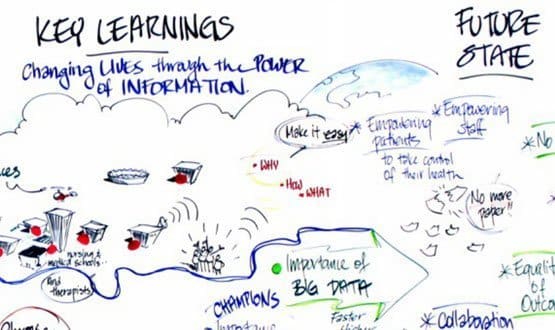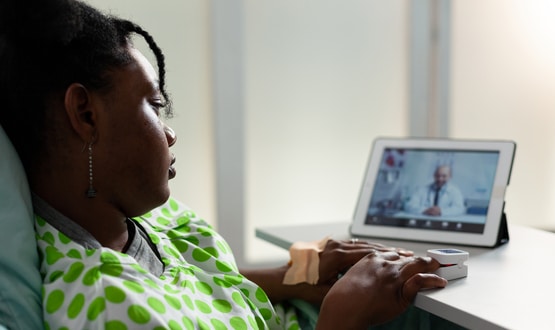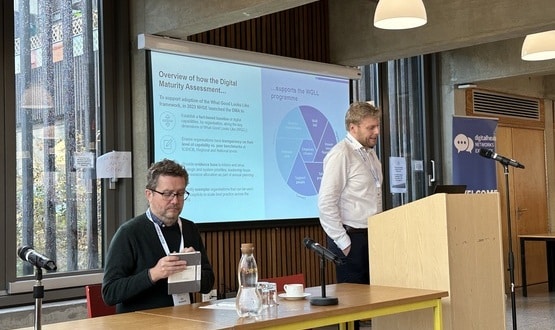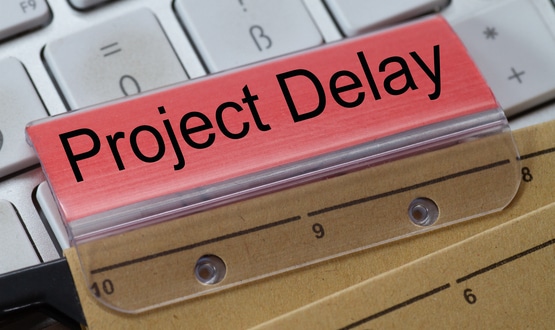No paper, no trauma
- 4 June 2013

In the A&E department of the Royal London Hospital, Dr Malik Ramadhan is searching for a piece of paper. Not a specific piece of paper, just any old piece of paper to show EHI what patient notes used to be written on.
Barts Health NHS Trust’s clinical director for emergency medicine returns from his second search empty-handed; and we agree that I can imagine what the notes would have looked like. We then crowd around one of the many computer screens to see what they look like now.
Knowing what is going on
Barts’ A&E is not paperless, but is certainly paper-lite. Using the Cerner Millennium FirstNet module, the A&E went paper-lite in paediatrics in January 2012 and in the adult department in September.
The team started with the registration process, which had been taking five minutes per patient, and reduced that to 60 seconds. The huge revolving carousels, full of patient files, were removed, leaving the space behind the receptionists starkly empty.
Once registered, a patient follows coloured arrows into the department, where a “navigator” at a “workstation on wheels” picks them up on their computer screen and allocates them to the space where they will be seen.
From there, they are tracked via Cerner, so that all staff can see who is waiting to be seen or waiting for tests or an inpatient bed. Observations are also entered directly into the system.
“We can see how ill all the patients are and what is happening to them. Everyone can see that, so when we have bed meetings we put this [information] up on the screen and see what’s happening in A&E,” Dr Ramadhan explains. “Before, nobody knew; nobody had any idea what was going on.”
In the bustling trauma area, matron Lorraine Shoker is on the phone, unsuccessfully trying to locate an inpatient bed. As we talk, a vacant bed pops up on the computer screen and the problem is resolved.
She describes going paper-lite as a “massive culture change”, but having made the change, staff would never go back. Indeed, they are now helping the medical admissions unit to go paper-lite.
Shoker’s experience is backed up by consultant in emergency medicine, Dr Mischa Heron, who explains that staff no longer spend their time chasing paper notes. Dr Heron, who is “not great on computers and can’t type”, argues that he if can go digital, anyone can.
The three-stranded strategy
Luke Readman joined Barts Health as chief information officer last September, six months after it was created through a merger between Barts and The London NHS Trust, Newham University Hospital NHS Trust and Whipps Cross University Hospital NHS Trust.
The business case for the merger says “all three trusts face infrastructure challenges, particularly in relation to information systems, aging technology and estates” and argues that the adoption of new technology and innovation will be key to the success of the integration.
“From an informatics perspective it was in a pretty raw state when I turned up: all the organisations had separate systems,” Readman explains.
A group of senior clinicians, nurses and managers was created to come up with an overall vision for IT. The first ideal to emerge from this was to have a single systems approach.
Barts and Newham are already using Cerner Millennium, although they are on different versions, and Whipps Cross is going to get it under the NPfIT contract before it runs out in October 2015.
Barts has announced that it will then buy Millennium under the London framework which is being used by seven London acute trusts with expiring NPfIT contracts. The other EPR suppliers on the framework are InterSystems and Epic.
The second goal is connectedness, meaning that wherever a patient is seen, assessed or treated, all the relevant information should be available; regardless of whether that is in hospital or in the community.
“We need to break out of this setting that has become established, which is that information is only available within organisational boundaries,” explains Readman.
The trust has agreed with GPs in Tower Hamlets to share information using the Medical Interoperability Gateway from Healthcare Gateway and Cerner’s Health Information Exchange.
This will give A&E doctors a live view of a patient’s summary GP record with their consent. “The value to a hospital, particularly in an emergency system, of seeing the drugs last prescribed in primary care setting is the biggest prize in all of that,” Readman says.
GPs in return will start to get pathology and radiology letters electronically.The first phase goes live between July and September.
The third strand is big data and information. Readman says there are many examples of data being used well in small pockets, but the creation of Barts Health is an opportunity to better harness all the information being collected about the population in the North East of London.
“Sharing information and bringing it all together in one place means we can get the power of that information for management and teaching and research and we need to build on that,” he argues.
Pictures tell a thousand words
Rather than taking a traditional approach by writing a long and complicated IT strategy, Barts chose to express this vision for IT in picture charts.
“These three themes resonate much more readily with the people who have to use these systems. Most people, I would hope, can see where they fit into that picture,” Readman says. “It’s always better to have a dialogue and tell a story than say ‘read this document’.”
The board has agreed on the principles and each individual project business case will go before it for approval. With that organisational consent, Readman’s team is now working on a formal strategy to be ready later this year.
Getting clinicians on-board
Barts’ newly appointed chief clinical information officer, Dr Charles Gutteridge, has four clinical information officers reporting to him from each of the trust’s sites.
He says the merger brought together three very separate, disparate organisations in different positions in terms of IT and that had to be taken into account when working on a joint IT strategy.
A key piece of work is helping clinicians at Whipps Cross to move from a position of quite low informatics capability to one that is relatively advanced.
“There’s a tremendous amount of activity going on at Whipps amongst leaders and informaticians to say we are going to do this,” Dr Gutteridge says.
Some Whipps Cross clinicians were anxious about the merger with two much bigger and potentially more powerful partners. Dr Gutteridge believes the huge investment in time and resource that is being made to bring Whipps up to speed in terms of IT should give them confidence about what the merger will do for the former trust.
Doctors are moving across the patch, seeing how technology can be used and pushing the agenda forward for all the sites.
“The use of an electronic health record is about clinical practice. It’s not about informatics or about computers, but about what I do when seeing a patient, taking a history and working out the diagnosis and best treatment,” he explains.
Where to from here?
Dr Ramadhan readily acknowledges that when Millennium was put in it had “lots of faults.” The scale of the problems that Barts faced with the new system helped to put a temporary stop to its implementation across London, and led to significant changes to the way it was deployed by BT.
Dr Ramadhan says it was frustrating for trust staff not be to able to go directly to the supplier to ask for faults to be fixed. He says that since the trust has been able to engage directly with Cerner, over the past 12-18 months, issues have been quickly fixed.
“When I arrived, the system had only just been put in and was being used badly. It was being blamed for being a poor system when it was a perfectly good system, being used badly,” he argues.
Once he started looking at how to use it well, life became easier. “Looking back to 2008, we never would have thought five years later that people would say ‘it’s a great system, we love it’, he says.
While it is certainly on the journey, the hospital is still not where Dr Ramadhan wants it to be. He believes Millennium needs to be more mobile, so staff can use it on tablets and smartphones. “I want this to be the flagship of the paperless and device-connected department,” he says.




